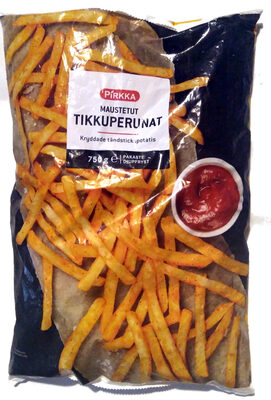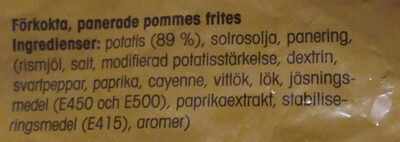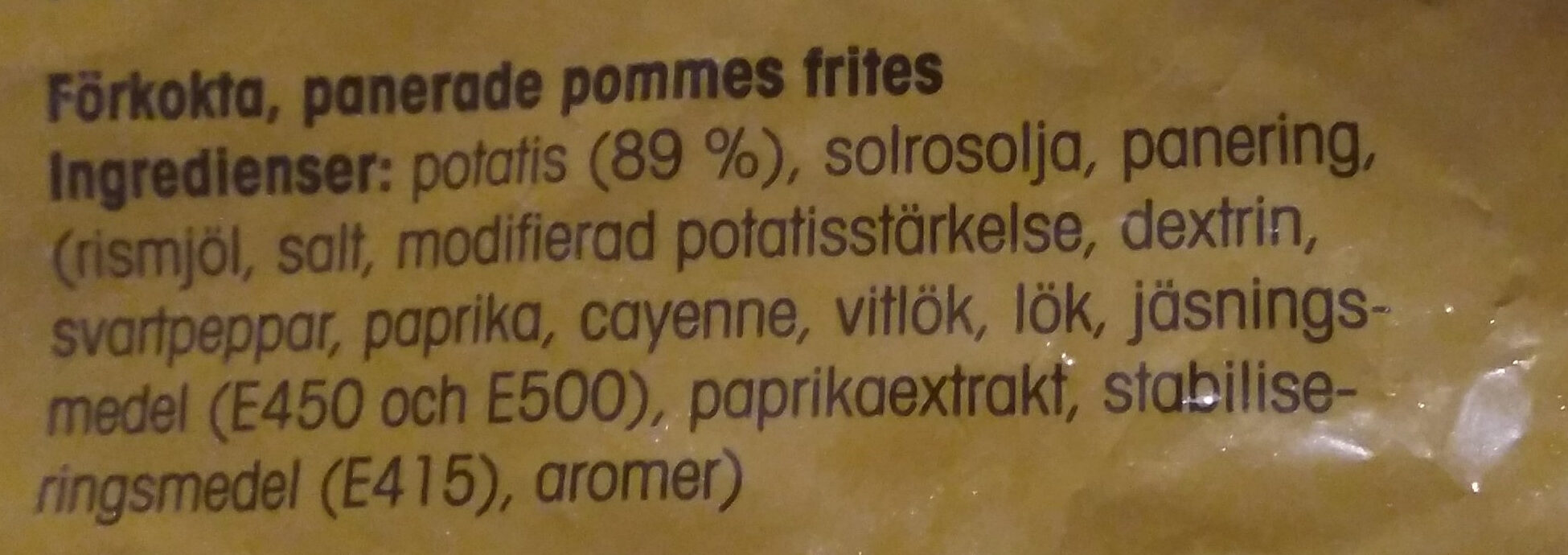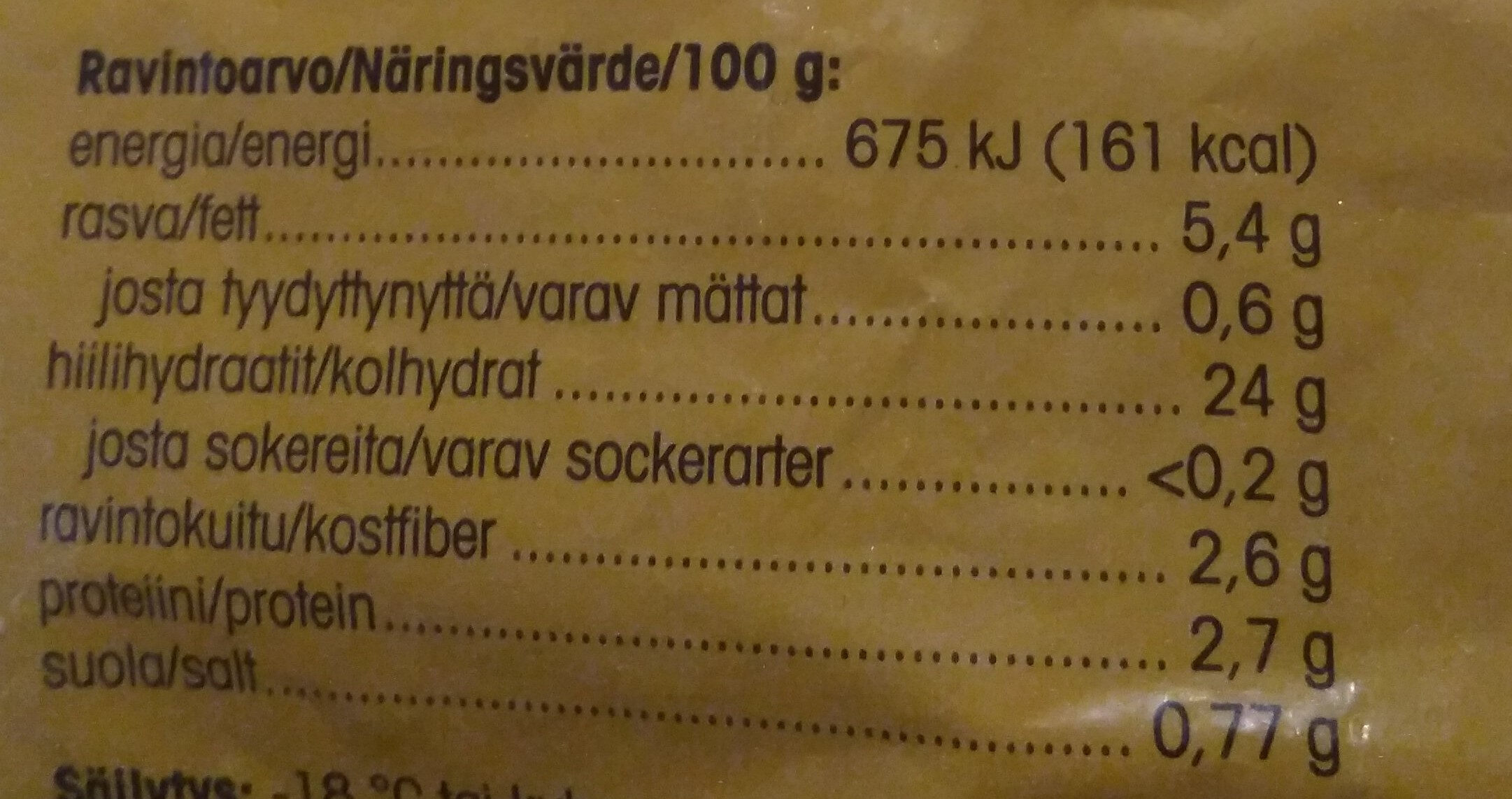Help us make food transparency the norm!
As a non-profit organization, we depend on your donations to continue informing consumers around the world about what they eat.
The food revolution starts with you!
Kryddade tändstickspotatis - Pirkka - 750g ℮
Kryddade tändstickspotatis - Pirkka - 750g ℮
This product page is not complete. You can help to complete it by editing it and adding more data from the photos we have, or by taking more photos using the app for Android or iPhone/iPad. Thank you!
×
Streckkod: 6410405136978 (EAN / EAN-13)
Vanligt namn: Förkokta, panerade pommes frites
Kvantitet: 750g ℮
Förpackning: Plast, en:Bag, en:ldpe-low-density-polyethylene, LDPE
Varumärken: Pirkka
Kategorier: en:Chips and fries, Fryst mat, en:Frozen fried potatoes, en:Fries, en:Frozen fries
Etiketter, certifieringar, utmärkelser: Icke EU-jordbruk, en:EU Agriculture, en:EU/non-EU Agriculture
Tillverknings eller bearbetningsplats: Belgium
Länk till produktsidan på producentens officiella webbplats: https://www.k-ruoka.fi/kauppa/tuote/pirk...
Butiker: K-market
Länder där såld: Finland
Matching with your preferences
Hälsa
Ingredienser
-
19 ingredienser
potatis (89 %), solrosolja, panering, (rismjöl, salt, modifierad potatisstärkelse, dextrin, svartpeppar, paprika, cayenne, vitlök, lök, jäsningsmedel (E450 och E500), paprikaextrakt, stabiliseringsmedel (E415), aromer)
Food processing
-
Ultra processed foods
Elements that indicate the product is in the 4 - Ultra bearbetade livsmedel och drycker group:
- Tillsats: E1400 - Dextrin
- Tillsats: E160c - Paprikaoleoresin
- Tillsats: E415 - Xantangummi
- Tillsats: E450 - Difosfater
- Ingrediens: Arom
Food products are classified into 4 groups according to their degree of processing:
- Obearbetade eller minimalt bearbetade livsmedel
- Bearbetade kulinariska ingredienser
- Halvfabrikat
- Ultra processed foods
The determination of the group is based on the category of the product and on the ingredients it contains.
Tillsatser
-
E1400 - Dextrin
Dextrin: Dextrins are a group of low-molecular-weight carbohydrates produced by the hydrolysis of starch or glycogen. Dextrins are mixtures of polymers of D-glucose units linked by α--1→4- or α--1→6- glycosidic bonds. Dextrins can be produced from starch using enzymes like amylases, as during digestion in the human body and during malting and mashing, or by applying dry heat under acidic conditions -pyrolysis or roasting-. The latter process is used industrially, and also occurs on the surface of bread during the baking process, contributing to flavor, color and crispness. Dextrins produced by heat are also known as pyrodextrins. The starch hydrolyses during roasting under acidic conditions, and short-chained starch parts partially rebranch with α--1‚6- bonds to the degraded starch molecule. See also Maillard Reaction. Dextrins are white, yellow, or brown powders that are partially or fully water-soluble, yielding optically active solutions of low viscosity. Most of them can be detected with iodine solution, giving a red coloration; one distinguishes erythrodextrin -dextrin that colours red- and achrodextrin -giving no colour-. White and yellow dextrins from starch roasted with little or no acid are called British gum.Källa: Wikipedia (Engelska)
-
E415 - Xantangummi
Xanthan gum: Xanthan gum -- is a polysaccharide with many industrial uses, including as a common food additive. It is an effective thickening agent and stabilizer to prevent ingredients from separating. It can be produced from simple sugars using a fermentation process, and derives its name from the species of bacteria used, Xanthomonas campestris.Källa: Wikipedia (Engelska)
-
E500 - Natriumkarbonater
Sodium carbonate: Sodium carbonate, Na2CO3, -also known as washing soda, soda ash and soda crystals, and in the monohydrate form as crystal carbonate- is the water-soluble sodium salt of carbonic acid. It most commonly occurs as a crystalline decahydrate, which readily effloresces to form a white powder, the monohydrate. Pure sodium carbonate is a white, odorless powder that is hygroscopic -absorbs moisture from the air-. It has a strongly alkaline taste, and forms a moderately basic solution in water. Sodium carbonate is well known domestically for its everyday use as a water softener. Historically it was extracted from the ashes of plants growing in sodium-rich soils, such as vegetation from the Middle East, kelp from Scotland and seaweed from Spain. Because the ashes of these sodium-rich plants were noticeably different from ashes of timber -used to create potash-, they became known as "soda ash". It is synthetically produced in large quantities from salt -sodium chloride- and limestone by a method known as the Solvay process. The manufacture of glass is one of the most important uses of sodium carbonate. Sodium carbonate acts as a flux for silica, lowering the melting point of the mixture to something achievable without special materials. This "soda glass" is mildly water-soluble, so some calcium carbonate is added to the melt mixture to make the glass produced insoluble. This type of glass is known as soda lime glass: "soda" for the sodium carbonate and "lime" for the calcium carbonate. Soda lime glass has been the most common form of glass for centuries. Sodium carbonate is also used as a relatively strong base in various settings. For example, it is used as a pH regulator to maintain stable alkaline conditions necessary for the action of the majority of photographic film developing agents. It acts as an alkali because when dissolved in water, it dissociates into the weak acid: carbonic acid and the strong alkali: sodium hydroxide. This gives sodium carbonate in solution the ability to attack metals such as aluminium with the release of hydrogen gas.It is a common additive in swimming pools used to raise the pH which can be lowered by chlorine tablets and other additives which contain acids. In cooking, it is sometimes used in place of sodium hydroxide for lyeing, especially with German pretzels and lye rolls. These dishes are treated with a solution of an alkaline substance to change the pH of the surface of the food and improve browning. In taxidermy, sodium carbonate added to boiling water will remove flesh from the bones of animal carcasses for trophy mounting or educational display. In chemistry, it is often used as an electrolyte. Electrolytes are usually salt-based, and sodium carbonate acts as a very good conductor in the process of electrolysis. In addition, unlike chloride ions, which form chlorine gas, carbonate ions are not corrosive to the anodes. It is also used as a primary standard for acid-base titrations because it is solid and air-stable, making it easy to weigh accurately.Källa: Wikipedia (Engelska)
Ingrediensanalys
-
Palmoljefri
No ingredients containing palm oil detected
-
Kanske Vegansk
Ingredients that may not be vegan: Arom
-
Kanske Vegetariskt
Ingredients that may not be vegetarian: Arom
-
Details of the analysis of the ingredients
: peruna 89%, auringonkukkaöljy, leivite (riisijauho, suola, muunnettu perunatärkkelys, dekstriini, mustapippuri, paprika, cayenne, valkosipuli, sipuli, nostatusaineet (e450, e500), paprikauute, stabilointiaine (e415), aromit)- peruna -> en:potato - vegan: yes - vegetarian: yes - ciqual_food_code: 4003 - percent_min: 89 - percent: 89 - percent_max: 89
- auringonkukkaöljy -> en:sunflower-oil - vegan: yes - vegetarian: yes - from_palm_oil: no - ciqual_food_code: 17440 - percent_min: 5.5 - percent_max: 11
- leivite -> en:breadcrumbs - vegan: maybe - vegetarian: maybe - ciqual_food_code: 7500 - percent_min: 0 - percent_max: 5.5
- riisijauho -> en:rice-flour - vegan: yes - vegetarian: yes - ciqual_food_code: 9520 - percent_min: 0 - percent_max: 5.5
- suola -> en:salt - vegan: yes - vegetarian: yes - ciqual_food_code: 11058 - percent_min: 0 - percent_max: 0.77
- muunnettu perunatärkkelys -> en:modified-potato-starch - vegan: yes - vegetarian: yes - ciqual_proxy_food_code: 9510 - percent_min: 0 - percent_max: 0.77
- dekstriini -> en:e1400 - vegan: yes - vegetarian: yes - percent_min: 0 - percent_max: 0.77
- mustapippuri -> en:black-pepper - vegan: yes - vegetarian: yes - ciqual_food_code: 11015 - percent_min: 0 - percent_max: 0.77
- paprika -> en:spice-or-bell-pepper - vegan: yes - vegetarian: yes - ciqual_food_code: 20041 - percent_min: 0 - percent_max: 0.77
- cayenne -> en:cayenne-pepper - vegan: yes - vegetarian: yes - ciqual_food_code: 11088 - percent_min: 0 - percent_max: 0.77
- valkosipuli -> en:garlic - vegan: yes - vegetarian: yes - ciqual_food_code: 11000 - percent_min: 0 - percent_max: 0.77
- sipuli -> en:onion - vegan: yes - vegetarian: yes - ciqual_food_code: 20034 - percent_min: 0 - percent_max: 0.611111111111111
- nostatusaineet -> en:raising-agent - percent_min: 0 - percent_max: 0.55
- e450 -> en:e450 - vegan: yes - vegetarian: yes - percent_min: 0 - percent_max: 0.55
- e500 -> en:e500 - vegan: yes - vegetarian: yes - percent_min: 0 - percent_max: 0.275
- paprikauute -> en:e160c - vegan: yes - vegetarian: yes - percent_min: 0 - percent_max: 0.5
- stabilointiaine -> en:stabiliser - percent_min: 0 - percent_max: 0.458333333333333
- e415 -> en:e415 - vegan: yes - vegetarian: yes - percent_min: 0 - percent_max: 0.458333333333333
- aromit -> en:flavouring - vegan: maybe - vegetarian: maybe - percent_min: 0 - percent_max: 0.458333333333333
Näring
-
Good nutritional quality
⚠ ️Warning: the amount of fruits, vegetables and nuts is not specified on the label, it was estimated from the list of ingredients: 0This product is not considered a beverage for the calculation of the Nutri-Score.
Positiva poäng: 3
- Proteiner: 1 / 5 (värde: 2.7, avrundat värde: 2.7)
- Fiber: 2 / 5 (värde: 2.6, avrundat värde: 2.6)
- Frukt, grönsaker, nötter och raps- / valnöt- / olivoljor: 0 / 5 (värde: 0.0283593750000002, avrundat värde: 0)
Negativa poäng: 5
- Energi: 2 / 10 (värde: 675, avrundat värde: 675)
- Socker: 0 / 10 (värde: 0.2, avrundat värde: 0.2)
- Mättat fett: 0 / 10 (värde: 0.6, avrundat värde: 0.6)
- Natrium: 3 / 10 (värde: 308, avrundat värde: 308)
The points for proteins are counted because the negative points are less than 11.
Näringsvärde: (5 - 3)
Nutri-Score:
-
Näringsvärden
-
Fett i måttlig kvantitet (5.4%)
What you need to know- A high consumption of fat, especially saturated fats, can raise cholesterol, which increases the risk of heart diseases.
Recommendation: Limit the consumption of fat and saturated fat- Choose products with lower fat and saturated fat content.
-
Mättat fett i låg kvantitet (0.6%)
What you need to know- A high consumption of fat, especially saturated fats, can raise cholesterol, which increases the risk of heart diseases.
Recommendation: Limit the consumption of fat and saturated fat- Choose products with lower fat and saturated fat content.
-
Sockerarter i låg kvantitet (0.2%)
What you need to know- A high consumption of sugar can cause weight gain and tooth decay. It also augments the risk of type 2 diabetes and cardio-vascular diseases.
Recommendation: Limit the consumption of sugar and sugary drinks- Sugary drinks (such as sodas, fruit beverages, and fruit juices and nectars) should be limited as much as possible (no more than 1 glass a day).
- Choose products with lower sugar content and reduce the consumption of products with added sugars.
-
Salt i måttlig kvantitet (0.77%)
What you need to know- A high consumption of salt (or sodium) can cause raised blood pressure, which can increase the risk of heart disease and stroke.
- Many people who have high blood pressure do not know it, as there are often no symptoms.
- Most people consume too much salt (on average 9 to 12 grams per day), around twice the recommended maximum level of intake.
Recommendation: Limit the consumption of salt and salted food- Reduce the quantity of salt used when cooking, and don't salt again at the table.
- Limit the consumption of salty snacks and choose products with lower salt content.
-
-
Näringsfakta
Näringsfakta Som såld
för 100 g / 100 mlCompared to: en:Fries Energi 675 kj
(161 kcal)+1 % Fett 5,4 g - Mättat fett 0,6 g +10 % Kolhydrat 24 g +4 % Sockerarter < 0,2 g −62 % Fiber 2,6 g Protein 2,7 g +13 % Salt 0,77 g +166 % Fruits‚ vegetables‚ nuts and rapeseed‚ walnut and olive oils (estimate from ingredients list analysis) 0,028 %
Miljö
-
Eco-Score A - Mycket låg miljöpåverkan
The Eco-Score is an experimental score that summarizes the environmental impacts of food products.→ The Eco-Score was initially developped for France and it is being extended to other European countries. The Eco-Score formula is subject to change as it is regularly improved to make it more precise and better suited to each country.Life cycle analysis
-
Average impact of products of the same category: A (Score: 96/100)
Kategori: Potato, pre-fried into cubes, frozen, raw
Kategori: Potato, pre-fried into cubes, frozen, raw
- PEF environmental score: 0.12 (the lower the score, the lower the impact)
- including impact on climate change: 0.97 kg CO2 eq/kg of product
Stage Impact Jordbruk
18.8 %Bearbetar
13.1 %Förpackning
20.8 %Transportation
16.1 %Distribution
22.8 %Consumption
8.5 %
Bonuses and maluses
-
Missing origins of ingredients information
Malus: -5
⚠ ️ The origins of the ingredients of this product are not indicated.
If they are indicated on the packaging, you can modify the product sheet and add them.
If you are the manufacturer of this product, you can send us the information with our free platform for producers.
-
Packaging with a medium impact
Malus: -8
Form Material Återvinning Impact Bag LDPE Hög
Eco-Score for this product
-
Impact for this product: A (Score: 83/100)
Produkt: Kryddade tändstickspotatis - Pirkka - 750g ℮
Life cycle analysis score: 96
Sum of bonuses and maluses: -13
Final score: 83/100
-
Carbon footprint
-
Equal to driving 0.5 km in a petrol car
97 g CO² per 100g of product
The carbon emission figure comes from ADEME's Agribalyse database, for the category: Potato, pre-fried into cubes, frozen, raw (Source: ADEME Agribalyse Database)
Stage Impact Jordbruk
12.8 %Bearbetar
11.6 %Förpackning
31.2 %Transportation
26.4 %Distribution
12.1 %Consumption
5.9 %
Förpackning
-
Packaging with a medium impact
-
Packaging parts
Bag (LDPE)
-
Packaging materials
Material % Packaging weight Packaging weight per 100 g of product Plast
-
Transportation
-
Origins of ingredients
Missing origins of ingredients information
⚠ ️ The origins of the ingredients of this product are not indicated.
If they are indicated on the packaging, you can modify the product sheet and add them.
If you are the manufacturer of this product, you can send us the information with our free platform for producers.Add the origins of ingredients for this product Add the origins of ingredients for this product
Report a problem
-
Incomplete or incorrect information?
Category, labels, ingredients, allergens, nutritional information, photos etc.
If the information does not match the information on the packaging, please complete or correct it. Open Food Facts is a collaborative database, and every contribution is useful for all.
Datakällor
Produkt tillagd den av jumati
Senast ändrad produktsida på av ecoscore-impact-estimator.
Produktsida också redigerad av openfoodfacts-contributors, packbot.










